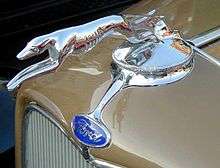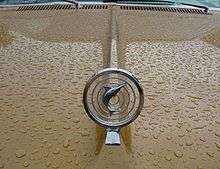Hood ornament
A hood/bonnet ornament, radiator cap, motor mascot or car mascot is a specially crafted model which symbolizes a car company like a badge, located on the front center portion of the hood. It has been used as an adornment nearly since the inception of automobiles.[2]
Origin
According to the author of A History of Cars written for youth, the first "hood ornament" was a sun-crested falcon (to bring good luck) mounted on Egyptian pharaoh Tutankhamun's chariot.[3]
In the early years, automobiles had their radiator caps outside of the hood and on top of the grille which also served as an indicator of the temperature of the engine's coolant fluid.[2] The Boyce MotoMeter Company was issued a patent in 1912 for a radiator cap that incorporated a thermometer that was visible to the driver with a sensor that measured the heat of the water vapor, rather than the water itself.[2] This became a useful gauge for the driver because many early engines did not have water pumps, but a circulation system based on the "thermo-syphon" principle as in the Ford Model T.
The "exposed radiator cap became a focal point for automobile personalization."[4]
Hood ornaments were popular in the 1920s, 1930s, 1940s, and 1950s, with many automakers fitting them to their vehicles. During the 1920s, advertisements for Mercedes-Benz emphasized their "star" hood ornament as representing the "world famous product of the oldest automobile works in the world" and as the ultimate symbol of luxury.[5]
Moreover, a healthy business was created in the supply of accessory mascots available to anyone who wanted to add a hood ornament or car mascot to their automobile. Most companies like Desmo and Smith's are now out of business with only Louis Lejeune Ltd. in England surviving. Sculptors such as Bazin, Paillet, Sykes, Renevey, and Lejeune all created finely detailed sculptures in miniature, like Statuettes.
Legal restrictions
Restrictions to the fitting of ornaments on the front of vehicles have been introduced in some jurisdictions. Projecting decorative designs on the hood may increase the risk of injury to pedestrians in the case of an accident.
Regulations introduced in the United States for the 1968 model year vehicles meant the disappearance of fixed stand-up hood ornaments, as well as spinner wheel protrusions.[6] Later versions featured flexibly mounted (spring-loaded) stand-up hood ornaments designed to fold without breaking on impact such as on the 1974 AMC Ambassador and on the 1986 Jeep Wagoneer (SJ).[7][8]
In the European Union, since 1974 all new cars have had to conform to a European directive on vehicle exterior projections.[9] Rolls Royce's mascot is now mounted on a spring-loaded mechanism designed to retract instantly into the radiator shell if struck with a force greater than 98 newtons (22 pounds-force). The Mercedes-Benz and many other ornaments were designed with a spring mount to fold on impact. For aftermarket ornaments, breakaway nylon fixings are available that comply with EC Directive 74/483.[10]
Branding
_jm20638.jpg)
Many automakers wanted their own emblems displayed on their vehicles' hoods, and Boyce Motormeter accommodated them with corporate logos or mascots, as well as numerous organizations that wanted custom cap emblems to identify their members.[2] The company had over 300 such customers at one time during the mid-1920s, for car, truck, tractor, boat, airplane, and motorcycle manufacturers, and in 1927, had 1,800 employees in six countries: U.S., England, Canada, Australia, France, and Germany. The hundreds of motor vehicle manufacturers before 1929 meant many customers for their customized emblems.[11]
Brand identification continues to be important "as firms try to distinguish their company's cookie-cutter SUV, sedan or pick-up truck from another company's cookie-cutter SUV, sedan or pick-up truck merely with a hood ornament or a name on the bumper."[12]
Examples
Along with the grille, the hood ornament is often a distinctive styling element and many marques use it as their primary brand identifier.
Examples of hood ornaments include:
- Archer on Pierce-Arrow cars[13]
- Ottawa leader Pontiac on Pontiac automobiles[14]
- Crest and wreath on Cadillac cars[15]
- Letter "B" with wings on Bentley cars
- Ball with wings on Horch cars
- Leaping jaguar on Jaguar Cars
- Lion rampant on Peugeot cars[16]
- Marlin on the American Motors fastback mounted within a round "sight"[17]
- Rocket on Oldsmobile cars[18]
- Rocky Mountain big horn ram's head on Dodge cars and trucks[19]
- Spirit of Ecstasy on Rolls-Royce Motor Cars[20]
- Stork on Hispano-Suiza cars[21][22]
- Three-pointed star surrounded by a circle on Mercedes-Benz sedans and wagons
- Trishields on Buick cars[23]
Additionally, many models such as Buick's Regal, the Chevrolet Impala, or Chrysler's Cordoba had their own unique emblem and accompanying distinctive standup hood ornament.
The importance of design
The radiator cap was transformed into an art form and became a way of individualizing the car, "representing a company's vision of the automobile", or "speaking volumes about the owner" of the vehicle.[2]
Materials used in manufacturing
Hood ornaments are usually cast in brass, zinc, or bronze and finished in a chrome plated finish. During the years when chrome plate was unavailable, they were plated in either silver or nickel. Some also incorporated other materials, such as plastic, bakelite, or colored glass.The 1950 Ford Custom DeLuxe hood ornament was molded in Plexiglas.[24] Others incorporated a light bulb for illumination at night. Pontiac featured a lighted Indian-head hood ornament through 1955 when it was replaced by flying V design.[25]
The best-known glass mascots were made by René Lalique in France.[26] Other sellers or producers of glass mascots include Sabino in France, Red Ashay in England, and Persons Majestic in the U.S. The latter two had their products made in Czechoslovakia. The Lalique company, like Louis Lejeune, is one of the few survivors from this era of motoring.
Collectibility
Some hood ornaments are attractive for more than the car's owners such as the red-white-and-blue golden lion crests that were on the hoods of 1950 Fords that children took to decorate their hats, belts, or bicycles.[27] The company solved the problem by offering a free miniature crest to all the kids that wrote letters requesting one.[27]
There is a collectors market for hood ornaments and car mascots.[28][29][30]
References
- Cranswick, Marc (2012). The Cars of American Motors: An Illustrated History. McFarland. p. 47. ISBN 978-0-7864-4672-8. Retrieved 29 October 2014.
...Marlin's hood ornament was redesigned, so it seemed less obtrusive.
- Hinckley, James; Robinson, Jon G. (2005). The Big Book of Car Culture: The Armchair Guide to Automotive Americana. MotorBooks/MBI Publishing. p. 9. ISBN 978-0-7603-1965-9. Retrieved 29 October 2014.
- Corbe, David (2006). A History of Cars. Gareth Stevens Publishers. p. 29. ISBN 9780836862867. Retrieved 29 October 2014.
- Witzel, Michael Karl (1996). Route 66 Remembered. Motorbooks. p. 31. ISBN 9780760301142. Retrieved 29 October 2014.
America's heyday for hood ornaments.
- Swett, Pamela E. (2013). Selling under the Swastika: Advertising and Commercial Culture in Nazi Germany. Stanford University Press. p. 118. ISBN 9780804788830. Retrieved 23 September 2019.
- "Detroit serves up the '68 models". Kiplinger's Personal Finance. 21 (9): 6. September 1967. Retrieved 29 October 2014.
- Ackerson, Robert C. (1993). Standard catalog of 4 x 4's: 1945-1993. Krause Publications. p. 481. ISBN 9780873412032. Retrieved 29 October 2014.
- Automotive Industries, Volume 149. Chilton. 1973. p. 39. Retrieved 23 September 2019.
- "Council Directive 74/483/EEC of 17 September 1974 on the approximation of the laws of the Member States relating to the external projections of motor vehicles". EUR-Lex. Retrieved 29 October 2014.
- "Car Mascots and English Law". Louis Lejeune. Retrieved 29 October 2014.
- Koma, Victor. "Reaching the Boiling Point: A History of Boyce Moto Meters". PreWarBuick.com. Retrieved 29 October 2014.
- Torres-Spelliscy, Ciara (2019). Political Brands. Edward Elgar Publishing. p. 5. ISBN 9781789901825. Retrieved 23 September 2019.
- Ralston, Marc (1980). Pierce-Arrow. A. S. Barnes. p. 151. ISBN 978-0-498-02451-1.
- Flory, J. Kelly (2008). American Cars 1946-1959: Every Model Year by Year. McFarland. p. 384. ISBN 978-0-7864-3229-5. Retrieved 29 October 2014.
- Hernandez, Lolita (2004). Autopsy of an engine and other stories from the Cadillac plant. Coffee House Press. p. 151. ISBN 978-1-56689-161-5.
- "Peugeot". Automobile Quarterly. 29 (1): 37. 1991. Retrieved 29 October 2014.
- Gunnell, John (2006). Standard Catalog of American Muscle Cars 1960-1972. Krause Publications. p. 9. ISBN 978-0-89689-433-4. Retrieved 29 October 2014.
- Clinard, Marshall Barron; Yeager, Peter C. (2005). Corporate crime. Transaction Publishers. p. 255. ISBN 978-1-4128-0493-6. Retrieved 29 October 2014.
- Hyde, Charles K. (2003). Riding the roller coaster: a history of the Chrysler Corporation. Wayne State University Press. p. 74. ISBN 978-0-8143-3091-3. Retrieved 29 October 2014.
- Crandall, Larry (March–April 1999). "The Spirit of Ecstasy". Tampa Bay Magazine. 14 (2): 133. Retrieved 29 October 2014.
- Fadón, Borja (31 May 2009). "Hispano Suiza, recuerdos de una época gloriosa". Motorpasion (in Spanish). Retrieved 20 May 2019.
- Koch, Jeff (12 December 2014). "The whole stor(k)y – why is there a bird on the radiator of that car?". Hemmings. Retrieved 23 September 2019.
- Gunnell, John (2004). Standard catalog of Buick, 1903-2004. Krause Publications. p. 254. ISBN 9780873497602. Retrieved 29 October 2014.
- Modern Plastics, Volume 28. Breskin & Charleton Publishing. 1951. p. 177. Retrieved 23 September 2019.
- "1955 Pontiac is all New". Popular Mechanics. 102 (5): 88–89. November 1954. Retrieved 23 September 2019.
- Wraight, Tony. "René Lalique pre-war Car Mascots article". Retrieved 29 October 2014.
- Gunnell, John (2011). Standard Catalog of Ford, 1903-2002: 100 Years of History, Photos, Technical Data and Pricing. Penguin. ISBN 9781440230387. Retrieved 23 September 2019.
- Alice, Michele (17 September 2006). "Collector's Corner: Automobilia - Hood Ornaments and Mascots". EcommerceBytes.com. Archived from the original on 30 October 2014. Retrieved 29 October 2014.
- "Vintage Hood Ornaments". collectorsweekly.com. Retrieved 29 October 2014.
- Suvak, David (2012). Test drive to Chicago: and other trips and tales. Xlibris. pp. 19–22. ISBN 9781479755530. Retrieved 29 October 2014.
External links
| Wikimedia Commons has media related to Hood ornaments. |
- "Automobile and Car Mascots". northstargallery.com. Retrieved 23 September 2019.
- "Photographs pf Hood Ornaments And Emblems Art for Sale". Jill Reger. Retrieved 23 September 2019.
- Dreßler, Matthias (2019). Kühlerfiguren klassischer Automobile 1909-1939 [Radiator Mascots of the Classic Car Era 1909-1939] (in German). Matthias Dreßler. ISBN 9783000608650.
- Weiner, Geoffrey George (2014). Unique Lalique mascots. Trans-Atlantic Publications. ISBN 9781909984219.
- Weiner, Geoffrey George (2017). Unique Lalique Mascots Volume 2. Grosvenor House Publishing. ISBN 9781786239037.






